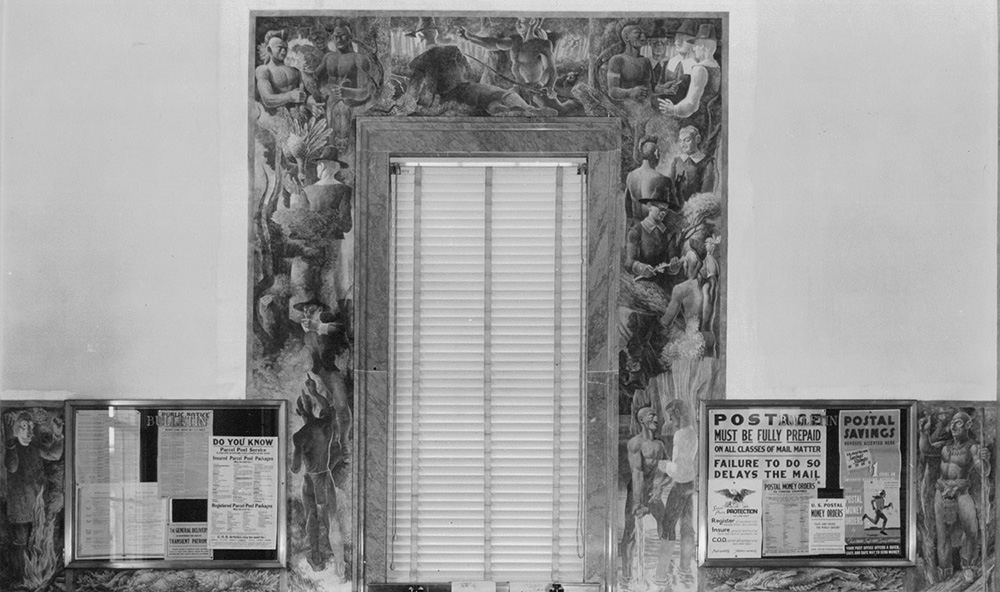
South Norwalk, Connecticut Post Office
Used with the permission of the United States Postal Service®.
Kindred McLeary's mural "Indians Instructing Pioneers in Forest Lore, Bays, and Oyster Fishing" was painted for the United States Post Office in South Norwalk, Connecticut. The mural depicts Pequot Indians teaching the pioneers how to perform these daily tasks. The mural is painted around multiple architectural features including a window. This combined with the artist’s tight positioning of the figures makes the image visually thought-provoking; yet, it is challenging to gain a full appreciation of what he has depicted. Beginning in the lower left section of the composition, a male figure, perhaps a pioneer, stands near a fire, with the glow of flames casting a peculiar light across his face. On the opposite side of the mural, McLeary illustrated a Pequot Indian, in a masculine stance, pointing a finger in the air. The central, and possibly most compelling, part of this mural are McLeary’s small vignettes that fill the areas on either side of the window. In these small scenes, the artist shows the Indians and the pioneers working together, with the Indians teaching the pioneers how to oyster fish, hunt, and live off of the land. The pioneers are presented as being attentive and interested in what they are being taught.
The Pequot Indians were hunter-gatherers and fishermen, who were protective of their territory. They occupied the southeastern coast of Connecticut, which began at the Niantic river and continued to Rhode Island. They had a fierce reputation, which their name "Pequot", meaning "destroyers", was derived from. In the early 1500s, the Pequot were part of the Mohican tribe, located in New York. By the 1600s, the Mohican had splintered and the Pequot elected to settle closer to the Connecticut coast. They grew various crops including squash, beans and corn, and are well-known for their talent as fishermen. Those skilled in fishing, provided shellfish such as oysters, lobsters, scallops, and clams, as well as pike and sturgeon ("Pequot Tribe: Facts, Clothes, Food and History"). Both the Indians and the European settlers practiced fishing as a means of collecting food, but the Europeans began crafting fishing boats as a way to fish larger quantities (Jones). The bays were essential to those living on the coast of Connecticut, as it provided a wealth of food. The hunter’s skill offered meats such as venison and moose. The skin of these animals, also provided the clothing that the Pequot people wore, before trade began with the Europeans. They adorned their bodies in paint and piercings, and used delicately created shell beads for exchange in ceremony ("Pequot Tribe: Facts, Clothes, Food and History").
The English colonists began to intrude on the Native Indian lands in 1620. They saw the native population as an objective for a conversion to Christianity. The groups coexisted for years, however, the Europeans usurped Indian lands, expanding their numbers, as well as their power (Harrell). Over the next decade, Pequot lands started to be claimed by the English and the Dutch. The relationship between the colonists and the Native people rapidly weakened and the Pequot War began. The war lasted until 1638; only a limited number of Pequot Indians survived. Most members of the tribe that remained, were eventually sold as slaves to the West Indies ("Pequot Tribe: Facts, Clothes, Food and History").
Today, there are two sections of Pequot tribes in existence. The Eastern Pequot Tribal Nation is located on a reservation named "Lantern Hill". This tribe has a population of approximately 1,000 members and is acknowledged by the state of Connecticut (Green). The Mashantucket Pequot, otherwise known as Western Pequot, are located in Ledyard, Connecticut. This tribe has an estimated 383 members and achieved federal recognition in 1983 ("Mashantucket Pequot Tribe").
Kindred McLeary was born in 1901 in Weimar, Texas. He was an architecture student at the University of Texas, as well as studied in France at the Fontainebleau School of Fine Arts, and in Rome at the American Academy. McLeary was an architecture professor at Carnegie Tech from 1928 until his death in 1949. He received accolades and is well-remembered for the murals that he painted in the Northeastern United States (McMahan). In the year 1941, McLeary painted "Indians Instructing Pioneers in Forest Lore, Bays, and Oyster Fishing" on plaster in Tempera. McLeary painted this mural, referencing the early and peaceful coexistence between the Pequot Indians and the pioneers. Among many others, the mural was a part of the Treasury Relief Art Project of 1935. The project funded works of art as a way of bringing art to the public with accurate depiction of the American scene (Limon).
The Post office in South Norwalk, Connecticut was built in 1936 and still contains this mural. Unfortunately, it can no longer be viewed by the public, as it was part of the space that was turned into offices during a 1963 renovation (Limon).
By Lauren Ferraro
More on indigenous people of the area:
http://www.easternpequottribalnation.com
and https://www.mptn-nsn.gov/default.aspx
Sources:
Green, Rick. "Eastern Pequots' Numbers Add Up." : Connecticut Breaking News -. The Hartford Courant, 06 Apr. 2002. Web. 22 Oct. 2015. <articles.courant.com/2002-04-06/news/0204061401_1_historic-tribe-federal-recognition-eastern-pequot-indians>.
Harrell, David Edwin. "Native Americans and The English." Unto a Good Land: A History of the American People. Vol. 1. Grand Rapids, MI: William B. Eerdmans, 2005. 61. Print. To 1900.
Jones, Capers. "The Colonial Economy of Narragansett Bay from 1600 to 1650: Subsistence Agriculture, Hunting, Fishing & Fur Trade." The History and Future of Narragansett Bay. Boca Raton, FL: Universal, 2006. 196. Google Books. Web. 3 Oct. 2015.
Limon, Sylvan. National Register of Historical Places Inventory -- Nomination Form. Lakewood: National Park Service, n.d. PDF.
"Mashantucket Pequot Tribe." EPA. Environmental Protection Agency, 19 Oct. 2015. Web. 22 Oct. 2015. epa.gov/region1/govt/tribes/mashantucket.html.
"Pequot Tribe: Facts, Clothes, Food and History." Warpaths2peacepipes.com. n.p. n.d. Web. 2 Oct. 2015.
Truman McMahan. "McLeary, Kindred." Handbook of Texas Online. Texas State Historical Association. 15 June. 2010. Web. 5 Oct. 2015.
